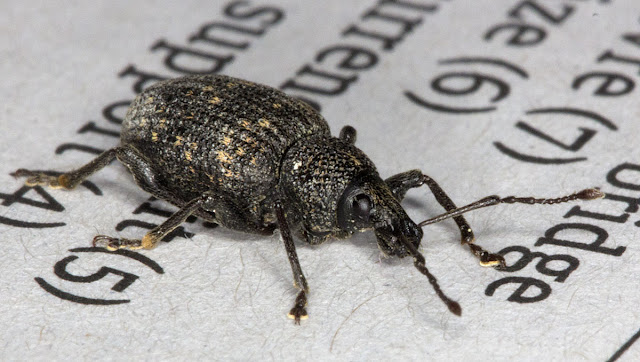 |
| Vine Weevil, Otiorhynchus sulcatus, photographed on the Guardian, 28 September 2011. |
Sunday 30 October 2011
Vine Weevil
Labels:
Hayes,
insects,
invertebrates,
mini-beasts
Location:
Hayes, Kent
Friday 28 October 2011
Two Garden Slugs
 |
| Large Black Slug, Arion ater, going for a chunk of mango in my back garden in Hayes, 7 September 2011. |
The creature in the top photo is called the Large Black Slug, but actually varies in colour. Back in Newcastle, they were all jet black. Here, they are mostly this mid-brown, though some are more yellow.
You can clearly see its mantle, its breathing pore and the stripy fringe. At the end of the tail is a little lump of mucus that picks up bits of the environment; bits of grit and plant debris in this case. This slug eats vegetation and carrion, but will not actually attack living prey.
Below is a Leopard Slug, so-called because of its appearance, but this one is also an active predator and goes after the little slugs as well as carrion. A group of these spend the day under the rim of my rainwater butt, cool and wet. Welcome to the garden, Limax!
 |
| Leopard Slug, Limax maximus, in my back garden in Hayes. 25 September 2011. |
Labels:
Hayes,
invertebrates,
mini-beasts,
slugs
Location:
Hayes, Kent
Wednesday 26 October 2011
Piece of Treetrunk
 |
| Piece of treetrunk in a clearing. West Wickham Common, 2 June 2011. |
The wood has been moved around several times since June.
Monday 24 October 2011
Twenty-Plume Moth
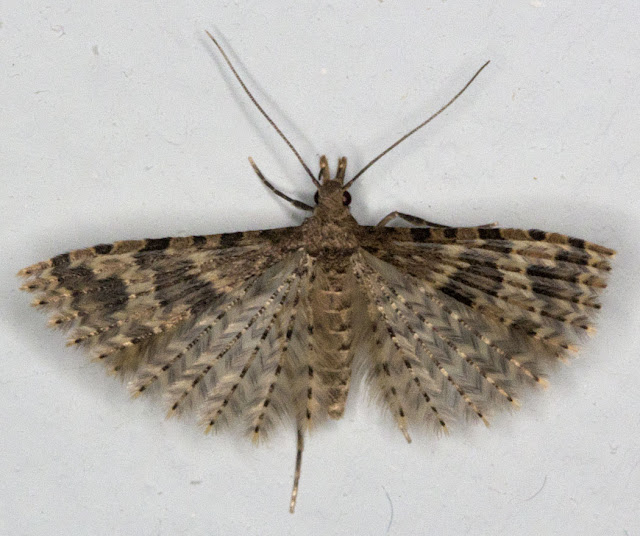 |
| Twenty-plume Moth, Alucita hexadactyla. Micromoth. 2 October 2011. |
As you can see, its wings are split into spines or plumes which are covered with fine hairs. Each wing has six plumes, so there are actually 24 altogether. Whoever named it was distressingly inaccurate, and I do not know why whoever gave it its Linnaic name referred to the plumes as fingers.
It's one of many moths that the books say are common, and yet I do not recall having seen it before. Perhaps because you need to look closely to see the plumes.
Labels:
insects,
invertebrates,
mini-beasts,
moths
Saturday 22 October 2011
Bumblebee on Greater Knapweed
 |
| Bumblebee, Bombus pascuorum, on Greater Knapweed, Centaurea scabiosa. Lullingstone Country Park, 14 October 2011. |
Labels:
flowers,
insects,
invertebrates,
Lullingstone Country Park,
mini-beasts
Location:
Lullingstone Country Park
Thursday 20 October 2011
Lesser Hawkbit
 |
| Lesser Hawkbit, Leontodon saxatilis. Lullingstone Country Park, 14 October 2011. |
This is a common enough flower, one of the many yellow-flowered composites that look a little like dandelions. This one looks as though someone has taken a paintbrush full of grey, outlined the sepals are run the brush up the outer petals.
I also took a shot of the flower full on, shown below, but I think the first one is much more pleasant and interesting.
 |
| Lesser Hawkbit, Leontodon saxatilis. Lullingstone Country Park, 14 October 2011. |
Labels:
flowers,
Lullingstone Country Park
Location:
Lullingstone Country Park
Wednesday 19 October 2011
A Popular Oak Leaf
 |
| Popular oak leaf on Hayes Common. 18 September 2011. |
I am no expert on galls, but they are interesting and some of them are easy to identify. Not these, unfortunately. This leaf has up to three different types. The large round one on the right might be a Striped Pea Gall, caused by the gall wasp Cynips longiventris, though it is not as colourful as I would expect. There are also some small green galls lower down the midrib, possibly younger versions of the same, though if so their timing is odd; and some small black ribbed galls on the side veins.
The tip of the leaf, on the right, is covered with droppings and silk strands, showing that something has been living there, curling the edge of the leaf around for protection. The same has happened where the edge of the leaf is curled under at the bottom of the photo.
The white patch in the middle is where something has eaten out the green goodness from between the upper and lower surfaces of the leaf.
There are holes where something has either eaten or taken away chunks of leaf.
There are some white cast-off skins showing where aphids have moulted.
And finally, I leave it to you to spot the scale insect, tucked in and hanging on quite happily.
Labels:
gall,
Hayes Common,
insects,
trees
Location:
Hayes Common
Tuesday 18 October 2011
Nail Galls
 |
| Nail galls on Small-Leaved Lime, Tilia cordata, caused by the gall mite Eriophyes lateannulatus. Farningham Wood, 2 October 2011. |
There are just two specimens in Farningham Wood, yet this is enough to support a species of nail gall mites that are unique to this species of tree. The nail galls on the more common lime tree, Tilia × europaea, are produced by a different mite and are noticeably larger at this time of year, as shown below!
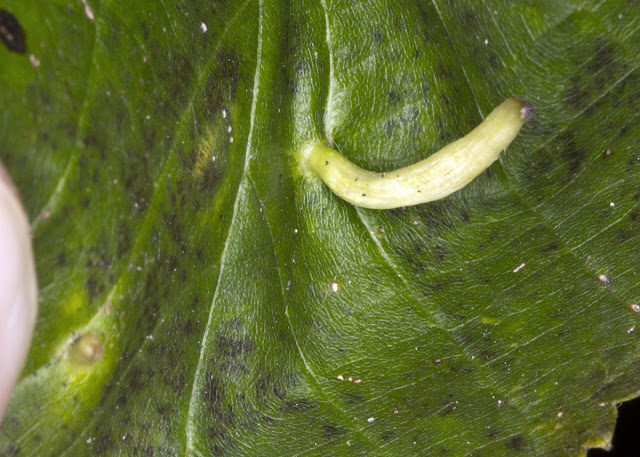 |
| Lime nail galls, caused by a mite, Eriophyes tiliae, on a lime tree in Cudham car park. 30 September 2011. |
Monday 17 October 2011
Yellow-Berried Holly
 |
| Holly, Ilex aquifolium, with yellow berries next to one with red berries. Hayes Common, 10 October 2011. |
Labels:
berries,
Hayes Common,
plants
Location:
Hayes Common
Sunday 16 October 2011
Magpie Ink Cap
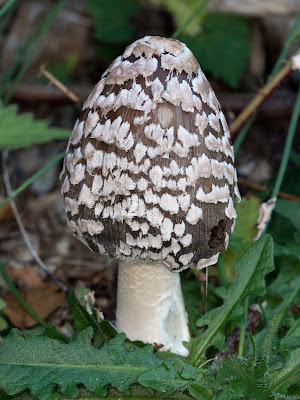 |
| Magpie Ink Cap, Coprinus picaceus. Farningham Wood, 2 October 2011. |
Wood chippings are great places to look for fungi, especially if, like these, they are in a shady spot and get plenty of dew. These were still wet at mid-day in the middle of a heat-wave.
This was one of the fungi we found. They are all the same species, but the top specimen is still young, and the lower two photos show a mature one almost ready to drop.
They are very showy and distinctive, and from under their cap emerges a strong chemical smell, reminiscent of mothballs; not camphor, which is sometimes used in mothballs and smells medicinal but not unpleasant, but the other, harsh kind. And not the same, but in the same class of smells. I apologise for this vague description, but there is nothing else in everyday life that compares.
The name "Ink Cap" derives from the black fluid they release when ripe. The colour comes from their spores.
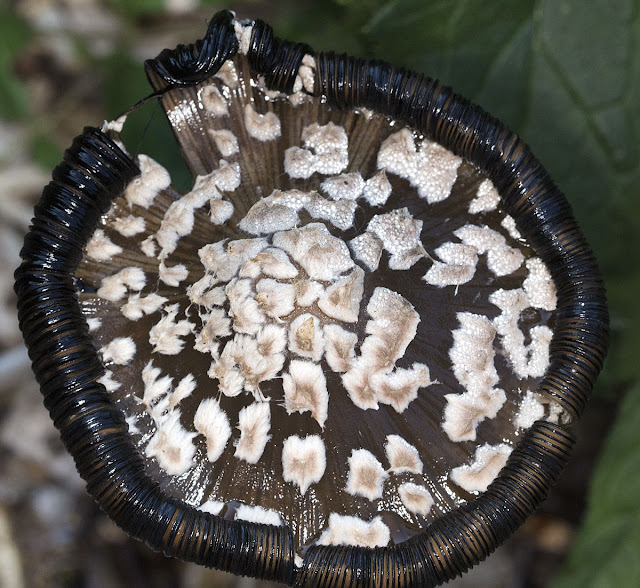 |
| Magpie Ink Cap, Coprinus picaceus. Farningham Wood, 2 October 2011. |
 |
| Magpie Ink Cap, Coprinus picaceus. Farningham Wood, 2 October 2011. |
Labels:
Farningham Wood,
fungi,
Orpington Field Club
Location:
Farningham Wood, Farningham, Kent, UK
Saturday 15 October 2011
November Moth
 |
| November Moth, Epirrita dilutata. Farthing Downs, 4 October 2011. |
It is most unusual for moths to stand with their wings up in butterfly fashion, but here it is. They do not normally rest with their hind wings visible either, so the second shot below is an unusual photo.
November Moths belong to a small group that all look very similar, and the field guide has diagrams of their genitalia, always a bad sign. But we are pretty sure of this one without resorting to a microscope.
They are not spectacular, but I like these photos.
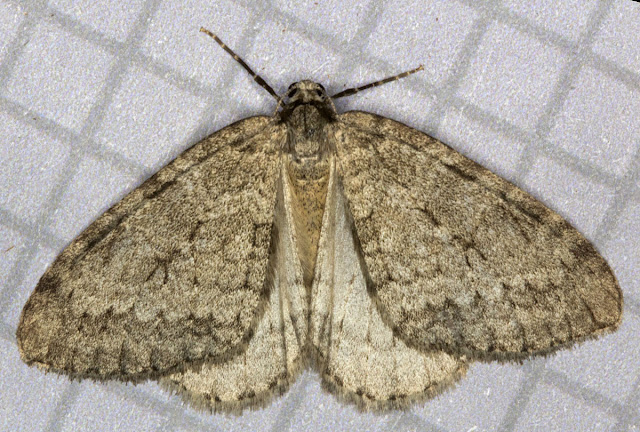 |
| November Moth, Epirrita dilutata, on a 5mm grid. Moth trap at Farthing Downs with Gill Peachey, 4 October 2011. |
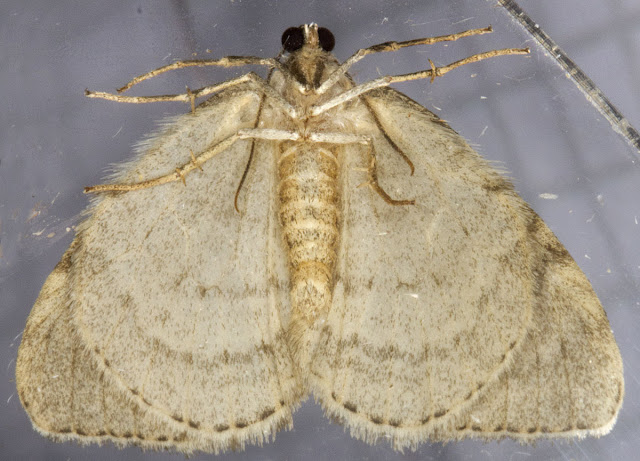 |
| November Moth, Epirrita dilutata. Geometer. Moth trap at Farthing Downs with Gill Peachey, 4 October 2011. |
Labels:
City Commons,
Farthing Downs,
insects,
invertebrates,
mini-beasts,
moths
Location:
Farthing Downs
Friday 14 October 2011
Badger Dung Pit
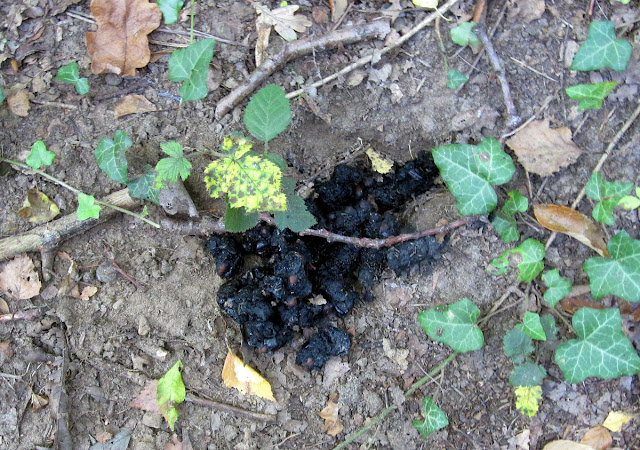 |
| Badger dung pit, Meles meles, on Hayes Common. 28 September 2011. |
These badgers have been eating something, maybe cherries, that have round stones. The dark colour suggests that they might also have been snacking on blackberries.
Thursday 13 October 2011
Cherry Stones
 |
| Cherry stones eaten by a vole. High Elms Country Park, 20 September 2011. |
Location:
High Elms Country Park
Wednesday 12 October 2011
More Farthing Downs Moths
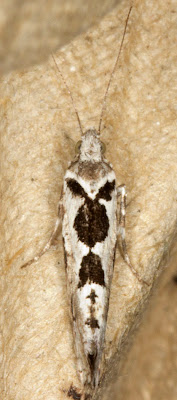 |
| Ypsolopha sequella . Micromoth. Farthing Downs, 4 October 2011. |
The small moth on the right is a micromoth, quite distinctive with that Bugs Bunny outline on its back. Gill Peachey, my informal tutor, does not work with micromoths, but even so, she knew it straight away.
We are starting to see the moths that really belong to the Autumn. I think that the two next down make a good contrasting pair; the Black Rustic does look quite black in normal light, with white pips on its wings, and it's only the strong light of the flash that brings out some detail. It has white underwings.
Further down is the Deep-Brown Dart, on which detail can be seen in normal light if you look carefully.
The Snout is impossible to mistake, even with a faded specimen like this, with its delta-wing shape and pointed facial outline.
The Barred Sallow and a normal Sallow would make a good pair, but the Sallow would not settle down and I couldn't get a photo.
And the last moth on this page is a Red-Green Carpet, quite showy in a dark sort of way. I like the way its eyes match the overall body and wing colour.
Finally, there were lots big ichneumon flies in the trap this time. I don't know the species, but they look quite dramatic.
 |
| Black Rustic, Aporophyla nigra (left) and Autumnal Rustic, Eugnorisma glareosa (right) Noctuids. Moth trap at Farthing Downs with Gill Peachey, 4 October 2011. |
 |
| Deep-Brown Dart, Aporophyla lutulenta. Noctuid. Moth trap at Farthing Downs with Gill Peachey, 4 October 2011. |
 |
| Snout, Hypena proboscidialis. Noctuid. Moth trap at Farthing Downs with Gill Peachey, 4 October 2011. |
 |
| Barred Sallow, Xanthia aurago. Noctuid. Moth trap at Farthing Downs with Gill Peachey, 4 October 2011. |
 |
| Red-Green Carpet, Chloroclysta siterata. Geometer. Moth trap at Farthing Downs with Gill Peachey, 4 October 2011. |
 |
| Unidentified ichneumon fly. Moth trap at Farthing Downs with Gill Peachey, 4 October 2011. |
Labels:
City Commons,
Farthing Downs,
insects,
invertebrates,
mini-beasts,
moths
Location:
Farthing Downs
Tuesday 11 October 2011
White Melilot
 |
| White Melilot, Melilotus albus, in Hayes Station car park. 18 September 2011. |
There is a small earth bank along the roadside, and cracks in the tarmac elsewhere where plants flourish.
Last year, there was a flush of Mugwort, Artemisia vulgaris. This year, hardly any of that; instead, lots of White Melilot, a plant I had not even heard of until earlier this year. I know northern plants pretty well, but there are still plenty in this area that are still new to me.
In fact I thought of this plant as belonging to a chalk grassland community, because that's where I first saw it, earlier this year at High Elms. But here it looks quite happy and healthy growing through tarmac on clay ground. This small patch is only part of it.
Although I doubt very much whether ecology is on their minds, the managers of this car park clear the plants once a year, in mid-September. These have gone now. That's quite good timing, as it allows many plants to mature and set seed, which gives me greenery to enjoy. I have already shown photos of thistles, horsetails and Prickly Lettuce from this car park, and I have photos of other plants too. It will be interesting to see what flourishes here next year.
Below is a shot from the first time I saw White Melilot.
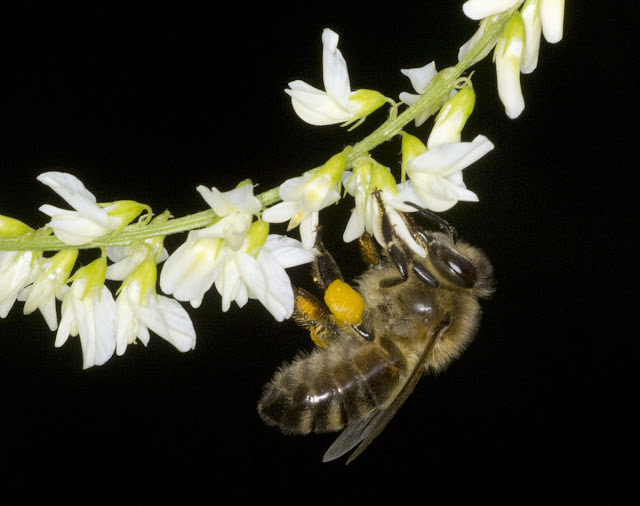 |
| Honey bee, Apis mellifera, on White Melilot, Melilotus albus, on Burnt Gorse at High Elms Country Park, 14 July 2011. |
Labels:
flowers,
Hayes,
High Elms,
insects,
invertebrates,
mini-beasts
Monday 10 October 2011
More Farningham Wood Fungi
 |
| Motorbike racing. Farningham Wood, 2 October 2011. |
The bikes were very noisy. At first it was just a murmur, but as we walked on the sound gradually became a foreground roar. I wouldn't have minded getting a bit closer to try for some dramatic photos, but reasonably enough the group headed away from them.
You can see that the soil there is pure sand. We, in the woods, were mostly on Blackheath Gravel, the same beds that my local commons are on (West Wickham Common, Hayes Common, Keston Common, Spring Park - all within walking distance; I feel well placed.) Despite the dry weather, there were quite a few fungi, and although many of them were dried up, old, or nibbled, they still make good photos.
First, the edge of a beefsteak fungus, a common wood-rotting bracket found on dead wood. It grows on my local oaks, but this one was on a chestnut tree. You can see the pores from which the spores fall when they are ripe.
 |
| Beefsteak fungus, Fistulina hepatica, on a chestnut tree. Farningham Wood, 2 October 2011. |
 |
| Leccinum aurantiacum. Nibbled by slugs in a scalloped pattern. Farningham Wood, 2 October 2011. |
 |
| Cortinarius species, on Willow. Farningham Wood, 2 October 2011. |
 |
| Mycena speirea next to a finger. Farningham Wood, 2 October 2011. |
 |
| Coprinopsis lagopus. Farningham Wood, 2 October 2011. |
 |
| Peziza species. Farningham Wood, 2 October 2011. |
 |
| Oak Powdery Mildew, Microsphaera alphitoides (or Erysiphe alphitoides). Fruiting. Farningham Wood, 2 October 2011. |
 |
| Unidentified fungus on the dead stem of a nettle. Farningham Wood, 2 October 2011. |
 |
| Decaying wood. Farningham Wood, 2 October 2011. |
 |
| Seed heads of Deptford Pink, Dianthus armeria. Farningham Wood, 2 October 2011. |
Labels:
Farningham Wood,
fungi,
Orpington Field Club,
plants
Location:
Farningham Wood, Farningham, Kent, UK
Sunday 9 October 2011
Morning Walk
 |
| Oak tree on Hayes Common, 22 September 2011. |
Saturday 8 October 2011
Misty Morning
 |
| Oak tree in light mist, Hayes Street Farm, 27 September 2011. |
Location:
Hayes Street Farm, off George Lane.
Friday 7 October 2011
Turkey Oak
 |
| Acorns of Turkey Oak, Quercus serris. High Elms Country Park, 20 September 2011. |
Turkey oaks are distinguished by their leaf shape, bristly bud tips, and those tentacle-like protrusions on the cups of the acorns, sometimes described as "mossy."
Even though this is a good year for nuts and berries, I could only see these two acorns on this tree.
Location:
High Elms Country Park
Thursday 6 October 2011
October Moths at Farthing Downs
 |
| Copper Underwing, Amphipyra pyramidea. Farthing Downs, 4 October 2011. |
The trap was full of interesting and instructive moths. 76 macromoths of 24 different species, and a few micros as well.
Of course, some of them were by now quite familiar, like the Copper Underwing on the right and the Large Yellow Underwing just below. I also saw a Broad-Bordered Yellow Underwing fluttering about the lamp as I arrived; I was quite excited, thinking we had a big new yellow moth, but the bright light on the strong colour of the rear wings had fooled me. It was great to see that a moth that looks like earth or a dead leaf when resting can be so vivid in flight.
 |
| Large Yellow Underwing, Noctua pronuba. Farthing Downs, 4 October 2011. |
Although I have seen lots of Large Yellow Underwings recently, I included this one because it has clear wing markings as well as that distinctive beak, which makes it a good example.
Gill made sure to pot up several specimens of three types of moth that can look very much alike, and all three of us pored over the books until we could distinguish them fairly easily. These are the Beaded Chestnuts, Brown-Spot Pinions and Lunar Underwings shown below. I have seen a dozen Lunar Underwings in my own trap, but only one of them was the brown shade that can let them be confused with these others; that shade seems to be more common here at Farthing Downs.
Some of these photos are on a rough card background; they are still resting in the egg-boxes that are left for them in the trap. Others are on grey, squared paper; those are 5mm sqares that I printed off, which allows a good size comparison however the photos might be processed.
A few others are in pots or on other surfaces, like the Copper Underwing above which is on the concrete next to the trap.
The most showy catch today was a Frosted Orange, which I will include at the bottom of this post. I will show more of these moths on another day.
 |
| Beaded Chestnut, Agrochola lychnidis. Noctuid. Moth trap at Farthing Downs with Gill Peachey, 4 October 2011. |
 |
| Brown-Spot Pinion, Agrochola litura. Noctuid. Moth trap at Farthing Downs with Gill Peachey, 4 October 2011. |
 |
| Lunar Underwing, Omphaloscelis lunosa. Noctuid. Moth trap at Farthing Downs with Gill Peachey, 4 October 2011. |
 |
| Brindled Green, Dryobotodes eremita. Noctuid. Moth trap at Farthing Downs with Gill Peachey, 4 October 2011. |
 |
| Large Ranunculus, Polymixis flavicincta. Noctuid. Moth trap at Farthing Downs with Gill Peachey, 4 October 2011. |
Finally, the showy one:
 |
| Frosted Orange, Gortyna flavago. Noctuid. Moth trap at Farthing Downs with Gill Peachey, 4 October 2011. |
Labels:
City Commons,
Farthing Downs,
insects,
invertebrates,
mini-beasts,
moths
Location:
Farthing Downs
Subscribe to:
Posts (Atom)